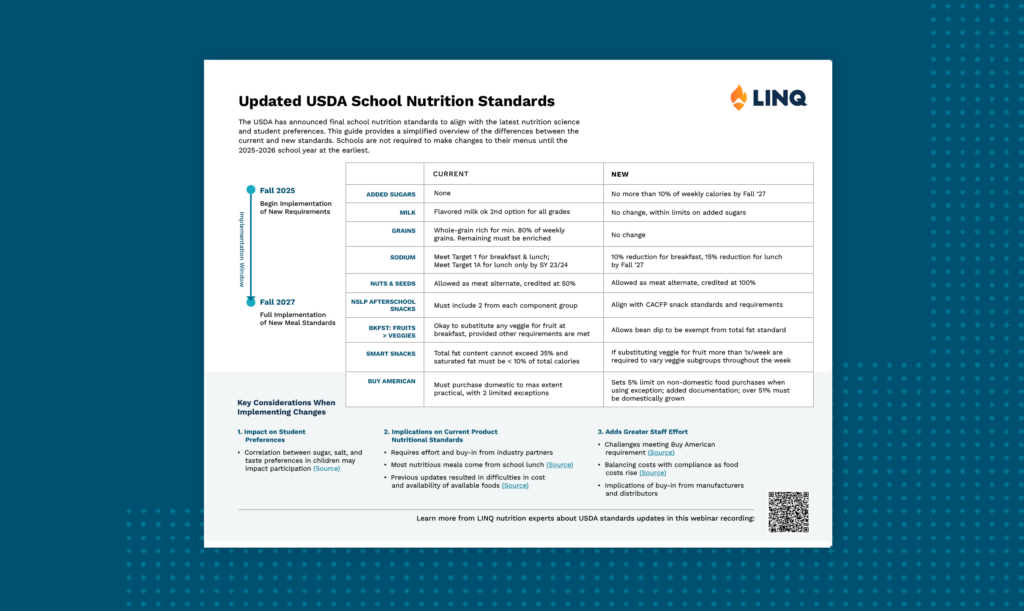The USDA unveiled updated school meal nutrition standards on April 24, 2024, revealing how and when schools need to make changes to comply. Most importantly, schools will not need to change menus to comply for the 2024-25 school year. The updates will gradually roll out between Fall 2025 and Fall 2027, and they reflect a collaborative effort informed by public feedback along with the latest scientific recommendations from the Dietary Guidelines for Americans.
What’s changing in the new USDA school meal nutrition standards:
Changes to sugar and salt content, as well as rules about flavored milk, overall came in less drastic than many feared. The final rules appear to strike a balance between regulators’ initial suggestions and K-12 nutrition leaders’ input. Notably, the whole grains standard remains unchanged, with 80% of weekly grains offered in school breakfast and lunch required to be whole-grain rich.
Flavored milk can stay, but breakfast and lunch meals will require reductions in sugar and salt content. While added sugar limits begin in 2025, school nutrition programs have until 2027 to gradually adjust to new salt limits. Additionally, the new standards encourage more protein-packed breakfasts and locally sourced agricultural products.
New USDA rules begin taking effect in 2025:
Added Sugars Limits (Beginning July 1, 2025):
- Breakfast cereals will be limited to 6 grams of added sugars per dry ounce
- Yogurt may contain no more than 12 grams of added sugars per ounce
Flavored Milk Limits (Beginning July 1, 2025):
- Flavored milk offered with lunch and breakfast may contain no more than 10 grams of added sugars per eight ounces
- In middle and high schools, flavored milk sold à la carte will be limited to 15 grams of added sugars per 12 ounces
School nutrition programs have until 2027 to meet new weekly added sugar limits and sodium reductions
The new rule changes require a sodium reduction of approximately 15% for school lunch and 10% for breakfast. Current sodium limits remain in effect until July 1, 2027, giving school nutrition leaders three full years to adjust. They can use that time to begin identifying and testing new recipes, ingredients, and packaged foods that comply with the updated requirements.
K-12 nutrition teams have time to meet new USDA standards, but challenges still lay ahead
Although the new USDA standards for school meals require districts and schools to follow stricter rules, the final rules aren’t meant to overwhelm nutrition leaders. “Schools and the food industry let us know that changes to the nutrition requirements need to be gradual and predictable,” the USDA writes in their announcement. By taking professional feedback into account, they issued a final set of rules designed to allow for planning and adaptation.
Katie Cossette, Director of Nutrition Services & Warehouse at St. Vrain Valley School District in Colorado, says she sees the effort to compromise in the final rules. “I was pleasantly surprised that USDA did listen to all of the responses to the final rule,” she explains, “and I do believe the new standards are pretty fair.”
That doesn’t mean there won’t be challenges, of course. DOE RISE Award winner Dawndrea Daly, Food Service Director at Wyoming’s Platte County School District #2, still expects difficulty staying compliant on top of other challenges school nutrition teams face. With rising costs and continuing staffing challenges, some programs may find themselves spending much of the next year sorting out solutions. However, Daly says, challenges aside, it won’t stop her from pursuing her mission to “feed the kids!”
School nutrition programs now know what to expect
For the past year, uncertainty swirled around what the new USDA rules would look like. From banning flavored milk altogether to taking favorite breakfast and lunch options off the menu, many wondered just how drastic the changes would be. The timeline was also in question as the 2024-25 school year drew nearer.
Now that the final rules have been announced and the guessing game is over, school nutrition leaders can focus on making the changes they need to implement before the new rules go into effect between 2025 and 2027.
Check out our USDA School Nutrition Standards “cheat sheet” for a summary of the latest changes.

